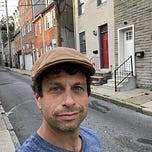On the last day of his life, after 120 years and 40 years of wandering, Moshe Rabbeinu gathers the people together on the banks of the Jordan River to offer them a final teaching.
אַתֶּ֨ם נִצָּבִ֤ים הַיּוֹם֙ כֻּלְּכֶ֔ם
“You stand today,” he says to them, “all of you, before the LORD your God” (Deu. 29:9). Rashi in 11th Century France explains we know it was his last day on earth because it says hayom, this day. This seems right, because a few chapters later, after Moshe has concluded his remarks, after charging the people to “choose life,” after bringing Yehoshua ben Nun before the people and charging him as their new leader, chazak v’ematz be strong and resolute, after drafting a poem we know as Ha’azinu – after a jam-packed final day – Torah tells us,
וַיְדַבֵּ֤ר ה֙ אֶל־מֹשֶׁ֔ה בְּעֶ֛צֶם הַיּ֥וֹם הַזֶּ֖ה לֵאמֹֽר׃
“That very day the LORD spoke to Moses: “Ascend these heights of Avarim to Mount Nebo, which is in the land of Moav facing Jericho, and view the land of Canaan, which I am giving the Israelites as their holding. You shall die on the mountain that you are about to ascend and shall be gathered to your kin…” (32:48-50).
It’s a bracing moment, the conclusion of an extraordinary life of service. The 16th Century Italian commentator Sforno adds that the reason our verse at the beginning of Nitzavim says not only hayom but also “lifnei Hashem Eloheichem, before the Lord your God,” is that Hashem’s presence is invoked to make clear that the people’s relationship with God will endure beyond their relationship with God through Moshe.
Here’s the rest of the passage Jon Hornstein leyned earlier: “You stand this day, all of you, before the LORD your God—your tribal heads, your elders and your officials, all the men of Israel, your children, your wives, even the stranger within your camp, from woodchopper to water drawer— to enter into the covenant of the LORD your God…as God promised you and swore to your fathers, Abraham, Isaac, and Jacob….
Notice how egalitarian this moment is! Everyone participates in the brit– leaders and followers, men, women, children, resident aliens, people of every trade. And then:
“I make this covenant, with its sanctions, not with you alone, but both with those who are standing here with us this day before the LORD our God
וְאֵ֨ת אֲשֶׁ֥ר אֵינֶ֛נּוּ פֹּ֖ה עִמָּ֥נוּ הַיּֽוֹם
and with those who are not with us here this day” (Deu. 29:9-14).
Numerous commentators, Rashi, Ibn Ezra, Ramban among them, suggest this last line is clear. It means that the covenant extends to future generations – to us.
Today, I would like to consider this moment and what it portends, both for those future generations, but more importantly what sort of model it establishes for Jewish communal gathering. Jews get together for lots of good reasons, of course, some overtly Jewish, some just because we like being together. We eat, we pray (yes, we love), but also, we tell jokes, watch football, organize for justice and go duckpin bowling. Aside from these and a million other good reasons to get together, I’m interested in what our sacred texts say is the optimal type of Jewish gathering.
When, chronologically speaking, is the next convocation similar to this moment in our parasha, when the whole community stands together in this way? We might look at II Kings (22:3) when, in the late 7th Century BCE, King Josiah sends for Hilkiah the Kohen Gadol to arrange for payment of laborers who are working on the Temple. It’s in this moment Hilkiah finds something extraordinary.
וַ֠יֹּ֠אמֶר חִלְקִיָּ֜הוּ הַכֹּהֵ֤ן הַגָּדוֹל֙ עַל־שָׁפָ֣ן הַסֹּפֵ֔ר סֵ֧פֶר הַתּוֹרָ֛ה מָצָ֖אתִי בְּבֵ֣ית ה …
“Then the high priest Hilkiah said to the scribe Shaphan, ‘I have found a scroll of the Teaching (sefer torah) in the House of the LORD.’ And Hilkiah gave the scroll to Shaphan, who read it.”
Josiah is completely distraught, concerned the community has, in its ignorance, been in violation of Torah law. In a memorable moment, it’s Huldah, the female prophetess, who reassures King Josiah that his sincere and humble supplications are accepted in heaven. Then, to rectify the Judean’s communal lack of knowledge, he assembles the community:
“At the king’s summons, all the elders of Judah and Jerusalem assembled before him.
The king went up to the House of the LORD, together with all the men of Judah and all the inhabitants of Jerusalem, and the priests and prophets—all the people, young and old. And he read to them the entire text of the covenant scroll (sefer habrit) which had been found in the House of the LORD” (II Kings 23:1-2). And then (v. 3): “All the people entered into the covenant.”
וַיַּעֲמֹ֥ד כׇּל־הָעָ֖ם בַּבְּרִֽית
Literally, they “stood” in the brit. Sort of like, “Atem nitzavim,” today you stand.”
So, we have another communal Torah moment, one marked by inclusion of the entire community, standing, and the language of covenant.
Two additional moments of note occur centuries later during the Persian Empire. One stands a bit outside of time. We don’t really know if the Purim story occurred in the way it’s described. Scholars think probably not. But the Rabbis view Megillat Esther as a window into the assimilating diasporic community of Shushan. That story, powerfully, becomes the model for communal acceptance of Torah.
Rabbi Avdimi bar Hama in the Bavli (Shabbat 88a) identifies a problem, not with Deuteronomy, not with King Josiah, but with the original moment of revelation, one could argue the very first Jewish communal gathering. Think way back to Parashat Yitro. The scene is pretty similar.
יּוֹצֵ֨א מֹשֶׁ֧ה אֶת־הָעָ֛ם לִקְרַ֥את הָֽאֱלֹהִ֖ים מִן־הַֽמַּחֲנֶ֑ה וַיִּֽתְיַצְּב֖וּ בְּתַחְתִּ֥ית הָהָֽר׃
Moses led the people out of the camp toward God, and they took their places at the foot of the mountain. Notice the word וַיִּֽתְיַצְּב֖וּ, same root as nitzavim. On the other hand, we don’t have an extensive list of attendees here. The original moment of revelation is not a model of inclusion, of women and men, of water drawers and wood choppers. In fact, the men are told to “distance” themselves from their wives. And it seems that the community can’t handle such a direct encounter with God, so they send Moshe up in their stead.
The Talmud goes even further, suggesting the people may not have been fully bought in to this project at all! “…And they stood at the lowermost part of the mount” (b’tachtit hahar) (Exodus 19:17). Rabbi Avdimi bar Ḥama bar Ḥasa said: the Jewish people actually stood beneath the mountain, and the verse teaches that the Holy One overturned the mountain above the Jews like a vault and said to them: If you accept the Torah, excellent, and if not, here will be your burial! Rav Aḥa bar Ya’akov said: From here there is a substantial caveat to Torah.
Could the covenant have been entered into under duress? That would be a problem, because if the Jewish people’s relationship with God is to be bi-directional and lasting, we must have agency in the decision. Even the “yoke of heaven” must be accepted willingly.
In classic Talmudic fashion, though, the Gemara solves its own problem. When do the Jewish people, as a people, finally accept Torah? Purim! “Rava said: Even so, they again accepted it willingly in the time of Ahasuerus, as it is written: “The Jews ordained, and took upon them, and upon their seed, and upon all such as joined themselves unto them” (Esther 9:27)
קִיְּמ֣וּ (וקבל) [וְקִבְּל֣וּ] הַיְּהוּדִים֩ ׀ עֲלֵיהֶ֨ם ׀ וְעַל־זַרְעָ֜ם
The Jews undertook and irrevocably obligated themselves and their descendants…
A less ahistorical version of Jewish communal gathering under the Persians comes from the book of Nechemiah. Nechemiah was cupbearer to King Artaxerxes. In the year 444 BCE, having learned about Jerusalem’s disrepair, he gets himself appointed governor of Judea and returns to Eretz Yisrael after about 13 years after Ezra the scribe.
Having rebuilt the walls and gates of Yerushalayim, Nehemia and Ezra gather for a renewal of the covenant (Neh. 8:1-3).
וַיֵּאָסְפ֤וּ כׇל־הָעָם֙ כְּאִ֣ישׁ אֶחָ֔ד
“The entire people assembled as one man in the square before the Water Gate, and they asked Ezra the scribe to bring the scroll of the Teaching of Moses with which the LORD had charged Israel.”
לְהָבִ֗יא אֶת־סֵ֙פֶר֙ תּוֹרַ֣ת מֹשֶׁ֔ה אֲשֶׁר־צִוָּ֥ה ה אֶת־יִשְׂרָאֵֽל׃
On what date does this occur? Rosh Hashanah!
“On the first day of the seventh month [remember the seventh month in Tanakh is Tishrei], Ezra the priest brought the Teaching before the congregation, men and women and all who could listen with understanding. [Again, an inclusive gathering]. He read from it, facing the square before the Water Gate, from the first light until midday, to the men and the women and those who could understand; the ears of all the people were given to the scroll of the Teaching.”
To give you a sense of just how inclusive the approach was to learning, Sefer Nehemiah (8:8) explains there were instructors circulating to ensure competency: “They read from the scroll of the Teaching [sefer torah] of God, translating it and giving the sense; so they understood the reading.”
That was in the 5th Century BCE. Our parashah takes place 700 years earlier, but the assurances given in that moment on the other side of the Jordan make possible that moment and each of the other moments of sacred communal gathering: “I make this covenant, with its sanctions, not with you alone, but both with those who are standing here with us this day before the LORD our God and with those who are not with us here this day” (Deu. 29:9-14).
I asked at the beginning if there was some great unifying theory of Jewish gathering? Inclusivity seems key, which is saying something in such a decidedly striated society. But why gather? What’s the agenda? Sorry to say, it’s not lox and bagel, nor necessarily prayer or volunteerism. It’s not watching television (though if you’re not yet watching Long Story Short on Netflix, you definitely should!). What links all these incidents is, of course, Torah learning, the public recitation of our holiest text Torah is the thing that holds Jews together. So, it has always been. So, may it continue to be so.
This year is our 50th Anniversary – in case you haven’t heard. It's not an accident we are celebrating by inaugurating a new sefer torah this Simchas Torah. It’s also not an accident that the last two mitzvot in the sefer torah are about the centrality of… Torah! From where do we learn the commandment for public torah reading? “Gather the people—men, women, children, and the strangers in your communities—that they may hear and so learn to revere the LORD your God and to observe faithfully every word of this Teaching” (Deu. 31:14) That’s next week’s portion, sometimes read as a double parashah with Nitzavim. The inclusivity of the entire community should sound familiar to you by now. And the final mitzvah, the 613th commandment, is to do what? To write a sefer Torah! (That mitzvah comes just five verses later, 31:19).
So, Hevre, let me leave you with this. On this Shabbat, the 27th of Elul, three days before Rosh Hashanah, in a shul which prides itself on its inclusive approach. (Dare I say it is part and parcel of Beth Am’s commitment to other principles, like diversity and… some other value I can’t recall, but I think it rhymes with “shmequity”). Anyway, if you distill our five core values down, this is a place that cares principally about two things: our machaneh (our broad and inclusive camp) and limmud, the centrality of Torah learning. So, how wonderful to discover that our tradition has always seen these two values as intrinsic to one another. This is at the core of the Brit. Torah is only worth giving to the entire nation, from the wood chopper to the water drawer, young and old, citizen and stranger. And the inverse is also true – an expansive community is best served by exposing the community to rich. deep, and relevant Torah learning.
Moses, our greatest teacher, on his last day of life, saw fit to commit the Jewish people to these principles. I don’t know about you, but they feel to me like worthy things to which we should recommit ourselves in the coming year.










